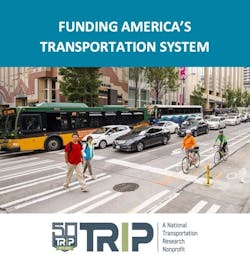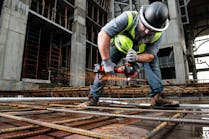Despite the increase in transportation funding provided by the passage of the Infrastructure Investment and Jobs Act (IIJA), the nation’s roads, bridges, and transit systems remain significantly underfunded, according to a new report from TRIP. In fact, says the report, even more investment is required for needed improvements and repairs.
Fees on highway users continue to be a critical source of funding for the preservation and improvement of the nation’s Interstate Highway System, other critical roads and bridges eligible for federal-aid, and the nation’s public transit systems, according to TRIP.
“Additional federal funding from the IIJA will help the U.S. move forward with needed improvements to the nation’s roads, bridges and transit systems that will enhance their condition, safety and efficiency,” said Dave Kearby, TRIP’s executive director, in a prepared statement. “Even with this significant boost in funding, the system remains significantly underfunded and will require increased, reliable and sustained investment to meet the transportation and economic goals of the 21st century.”
The federal Highway Trust Fund (HTF) is the primary source of revenue for the IIJA and receives its revenues exclusively from highway user fees—taxes on motor fuels and other specified motorist purchases—and from interest on its existing balance (owed by the federal government on money borrowed from the Trust Fund). The HTF is deficit proof, financing road, bridge and transit improvements on a pay-as-you-go basis. The federal motor fuel tax is 18.4 cents per gallon for gasoline and 24.4 cents per gallon for diesel fuel. It has been increased five times since 1956, with the most recent increase in 1997.
TRIP’s new report evaluates the condition, use, and funding of the nation’s system of roads, bridges and transit. “Funding America’s Transportation System” finds that, as vehicle travel reaches pre-pandemic levels, 40 percent of the nation’s major roads are in poor or mediocre condition, and seven percent of bridges are rated in poor/structurally deficient condition. The report also finds that traffic fatality rates are the highest in a decade, 42 percent of the nation’s busiest roads experience congestion during peak travel times, and one-fifth of transit vehicles have met or exceeded their useful service life.
The IIJA will provide a significant boost in federal investment in roads, bridges and transit and offers an opportunity for the nation to make progress in improving the safety, reliability and condition of the transportation system. The IIJA will provide $454 billion over the five-year period from 2022 to 2026 for investment in highways and transit, resulting in a 38 percent increase in federal investment in 2022. The report’s Appendix includes the total revenue each state will receive over the next five years as a result of the IIJA, and the percentage increase in 2022.
As U.S. vehicle miles of travel (VMT) return to pre-COVID-19 levels, the nation’s highways are again congested, hindering the movement of people and goods. Overall VMT bottomed out in April 2020 at a level 40 percent below April 2019. By December 2021, U.S. VMT was just one percent below December 2019 levels (the most recent pre-COVID December), and VMT rates in 24 states now exceed pre-pandemic levels. Forty-two percent of the nation’s Interstates, freeways and expressways experience congestion during peak travel times, robbing commuters of time and money and imposing increased costs on businesses, shippers and manufacturers. The report’s Appendix includes the rate of VMT change in each state from December 2019 to December 2021 and the share of Interstates, freeways and expressways in each state that are considered congested during peak travel times.
The nation’s traffic fatality rate of 1.34 fatalities per 100 million vehicle miles of travel in 2020 is significantly higher than the 2019 rate of 1.11 and is the highest fatality rate in the last 10 years, underscoring the need for improved roadway safety investments. A total of 38,824 people were killed in traffic crashes in the U.S. in 2020. The report’s Appendix includes the number of 2020 traffic fatalities and traffic fatality rate in each state.
The significant deficiencies on the nation’s roads, bridges and transit systems hamper mobility and access and impose additional costs on drivers. Nationwide, 19 percent of major locally and state-maintained roads are in poor condition and 21 percent are in mediocre condition. On the nation’s urban roads, which carry 69 percent of all vehicle travel, 32 percent are in poor condition and 24 percent are in mediocre condition. TRIP estimates that additional vehicle operating costs borne by U.S. motorists as a result of deteriorated road conditions is $141 billion annually, an average of $621 per driver. These additional vehicle operating costs (VOC) include accelerated vehicle depreciation, additional vehicle repair costs, increased fuel consumption and increased tire wear. The Appendix includes the share of overall and urban pavements in poor and mediocre condition in each state and the total and per-driver additional VOCdue to driving on deteriorated roads.
Seven percent (43,586 of 619,622) of the nation’s locally and state-maintained bridges are rated in poor/structurally deficient condition and 48 percent are rated in fair condition. A bridge is deemed structurally deficient if there is significant deterioration of the bridge deck, supports or other major components. Most bridges are designed to last 50 years before major overhaul or replacement, although many newer bridges are being designed to last 75 years or longer. Forty percent of the nation’s bridges are more than 50 years old. The Appendix includes the share of bridges in each state that are rated in structurally deficient/poor condition and the share of bridges that are more than 50 years old.
The nation’s 2,250 transit systems provide access to employment, education, health care, shopping, recreation and social activities. In 2020, 20 percent of transit vehicles, including buses, rail cars and demand response vehicles, had met or exceeded their useful service life. Included in the report’s Appendix is the share of transit vehicles exceeding their service life in each state.
In order to improve the condition and performance of the nation’s network of roads, highways, bridges and transit systems, a significant increase in investment levels will be required to offset the large backlog in needed funding. According to the Status of the Nation’s Highways, Bridges and Transit: Conditions and Performance Report to Congress released by the United States Department of Transportation in 2021, the U.S. would need to increase annual road, highway and bridge investment by 55 percent to make significant improvements in road and bridge conditions, reduce traffic congestion and improve traffic safety. The report also found that the U.S. would need to increase annual transit investment by 31 percent to make significant improvements in the condition of transit vehicles and facilities and to increase ridership.
Source: TRIP





